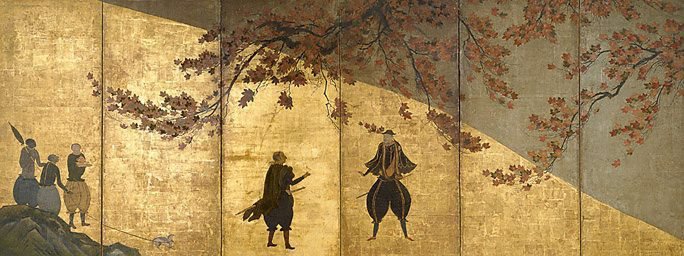-
Details
- Place where the work was made
-
Japan
- Period
-
Edo (Tokugawa) period 1615 - 1868
→
Japan
Momoyama period 1573 - 1615 → Japan - Date
- late 16th century-early 17th century
- Media category
- Painting
- Materials used
- single six-panel screen; ink and colours on gold-leafed paper
- Dimensions
- 152.0 x 369.0 cm image; 152.0 x 370.2 cm screen
- Signature & date
l.r., in Japanese ink "[artist's seal]". Not dated.
- Credit
- Purchased 1996
- Location
- Not on display
- Accession number
- 301.1996
- Copyright
- Artist information
-
Kanō School
Works in the collection
- Share
-
-
About
The first Westerners to reach the shores of Japan were Portuguese seamen who, on route to their regular trading posts in South-east Asia, were blown off course in 1542. Subsequently the Portuguese established trading posts in Japan (initially in Nagasaki), and the arrival of these strange people with their odd clothes and seemingly invincible ships naturally caused immense curiosity among the Japanese. These new and unexpected arrivals were known as 'namban', 'southern barbarians', as they always arrived in Japan from the south. Their presence, and the Japanese fascination with these exotic commercial itinerants, gave rise to a whole artistic genre. This beautiful and atmospheric screen was originally one of a pair. It is an exceptional example of this relatively rare genre, combining the classic Japanese sensitivity to seasonal moods, and the abstract stylisation of the Japanese decorative instinct. The screen illustrates an ascending hierarchy from left to right; beginning with the group of three servants, one of whom is holding a dog on a leash. In the centre is a senior member of the ship's crew, and on the right the captain-major.
Art Gallery Handbook, 1999. pg. 270.
-
Places
Where the work was made
Japan
-
Exhibition history
Shown in 3 exhibitions
The art of Japanese screen painting, Art Gallery of New South Wales, Sydney, 06 Nov 2004–06 Feb 2005
In one drop of water, Art Gallery of New South Wales, Sydney, 15 Jun 2019–21 Feb 2021
Correspondence, Art Gallery of New South Wales, Sydney, 10 Sep 2022–2024
-
Bibliography
Referenced in 6 publications
-
Jean Buhot, Revue des Arts Asiatiques, Paris, 1938, 123-24 (illus.). plate no .45
-
Bruce James, Art Gallery of New South Wales handbook, 'Asian Collection: East Asia', pg. 246-287, Sydney, 1999, 270 (colour illus.).
-
Jackie Menzies, Orientations, 'Japanese Figure Painting: From the Public to the Personal', pg. 114-119, Hong Kong, Sep 2000, 114-115 (colour illus.). fig.1
-
Jackie Menzies, TAASA Review, "Art Gallery of New South Wales", Sydney, Mar 1998, 8 (colour illus).
-
Jackie Menzies (Editor), The Asian Collections Art Gallery of New South Wales, 'The World of Samurai Culture', Sydney, 2003, 216-217 (colour illus.). The colour illus. on page 217 is a detail of this work.
-
Public Programmes Department, Art Gallery of New South Wales and The Japan Foundation (Editors), Art speaks Japanese: Japanese language education kit from the collection of the Art Gallery of New South Wales, Sydney, 2007, colour illus.. card no. 02
-
-
Provenance
Eskenazi Ltd Oriental Art, May 1996, London/England, purchased by the Art Gallery of New South Wales, Sydney, 1996.
